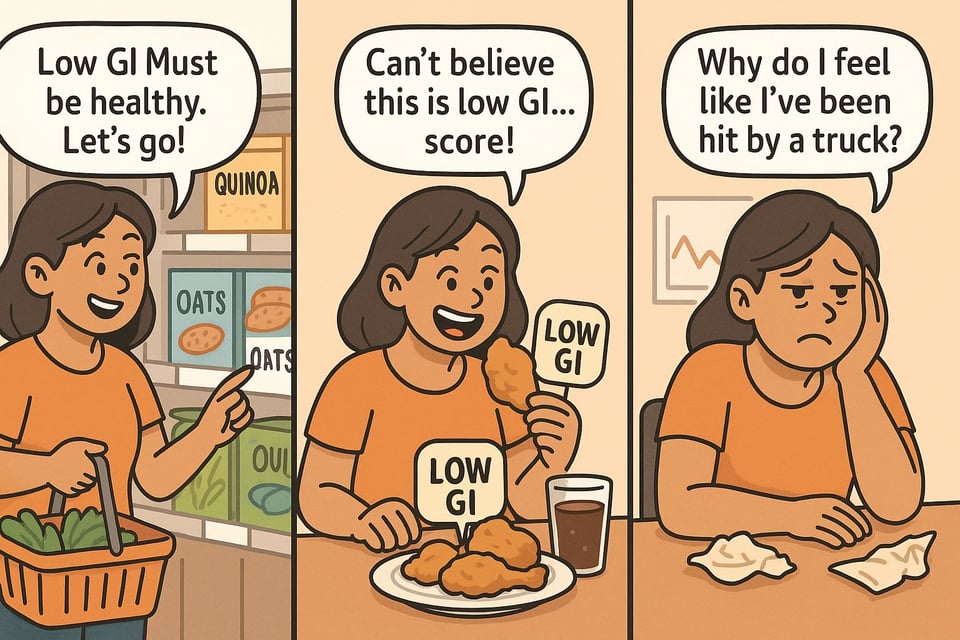What’s the Glycemic Index, and Why Should We Care?

The Glycemic Index: What It Really Means for Your Blood Sugar
Ever wonder why eating a bowl of white rice can leave you in a post-lunch slump, but a quinoa salad keeps you buzzing?
That’s the glycemic index (GI) at work—your blood sugar’s version of a speedometer. And while “low GI” foods often get labeled as healthier, the truth is... it’s not that simple.
Let’s unpack why.
🍭 What Is the Glycemic Index, Really?
Think of GI as the sugar-speed rating of your food. It measures how fast a carbohydrate-rich food raises your blood sugar after eating.
It was originally developed in the 1980s by Dr. David Jenkins to help people with diabetes manage their glucose more effectively.
Low GI (≤55): Slow and steady—like a gentle cruise 🚗
Medium GI (56–69): Somewhere in the middle—could go either way
High GI (70+): Sugar on a rollercoaster 🎢
Fast sugar spikes mean your body has to pump out more insulin quickly—and that rollercoaster ride? It can leave you tired, cranky, and snack-hungry.
🍽️ Real-Life Test: Alex vs. Jamie
Meet Alex and Jamie at breakfast.
Alex grabs a bagel and orange juice (high GI combo).
Jamie chooses eggs, avocado, and whole grain toast (lower GI and balanced).
A couple hours later, Alex is yawning and searching for snacks. Jamie’s still energized.
That’s not metabolism magic—it’s glucose behavior.
❌ The “Low GI = Healthy” Myth
Here’s the catch: not all low GI foods are good for you.
Ice cream and chocolate milk? Low GI.
Why? Fat slows down digestion, which makes sugar hit your bloodstream more gradually.
But they’re still high in sugar, calories, and often low in nutrients. A low GI score doesn’t give them a nutritional gold star.
👉 GI is a tool—not a health rating.
🍗 Fried Chicken Trap: When GI Misleads You
Let’s go deeper.
Fried chicken? Also low on the glycemic index. But that doesn’t mean it’s a friend to your blood sugar.
Why it's misleading:
High in saturated fat
Often ultra-processed
Can promote insulin resistance over time
Usually eaten with high-GI sides like fries or soda
Low GI here just means the sugar spike is slower—but the metabolic damage can still be real.
✌️ Your Takeaway
Think of the glycemic index as your food’s sugar speed limit—but remember, speed isn’t everything.
🛑 Fried chicken might have good “brakes,” but it’s still terrible “fuel.” Bad fuel clogs the engine—and over time, that engine can stall.
✅ The winning combo: slow carbs + protein + fiber + healthy fats. That’s how you flatten the glucose curve and keep your energy steady.
🔜 Coming Up Next Week…
We’ve talked speed—now let’s talk volume.
Next week, we’re diving into Glycemic Load—a concept that adds context to GI by asking how much sugar a food delivers, not just how fast.
Still feeling like food and glucose are a mystery?
Don’t stress—stress doesn’t help your sugar, anyway.
Leave it to GlucoSpike AI to decode the patterns. No sensors. No manual tracking. Just smart insights based on what you eat.
Progress doesn’t need to be complicated. Just simple and consistent.
See you next week,
—Team GS
